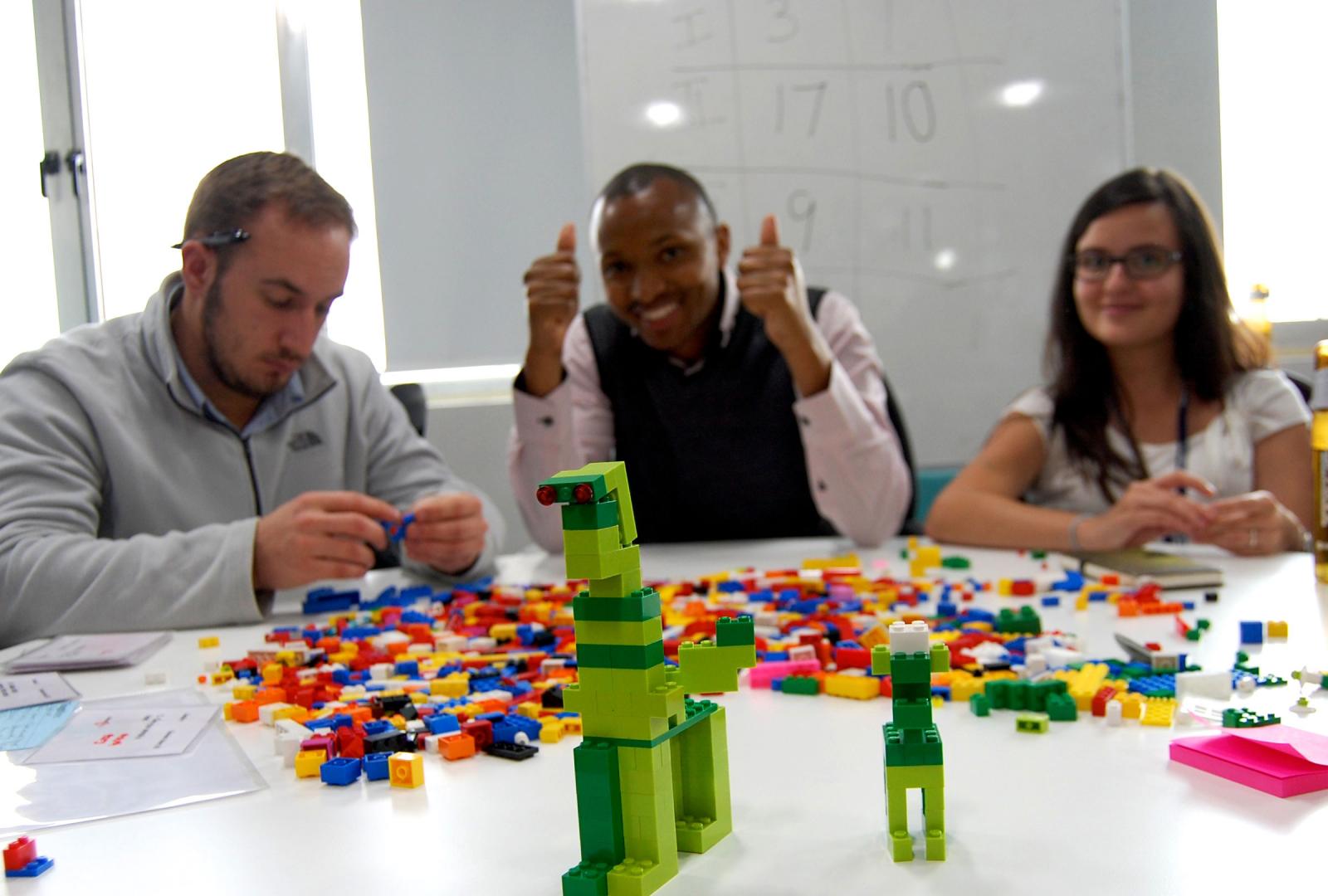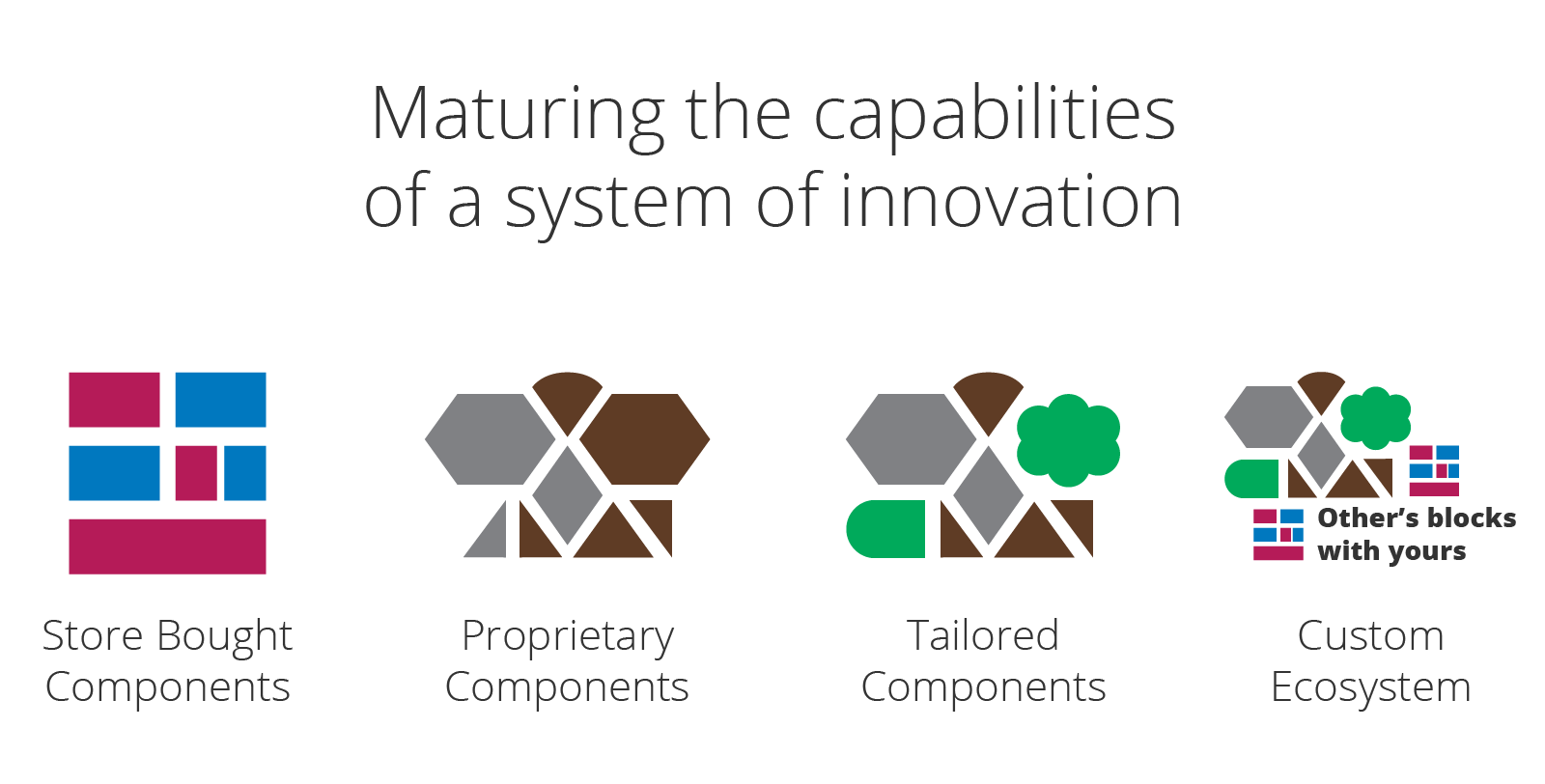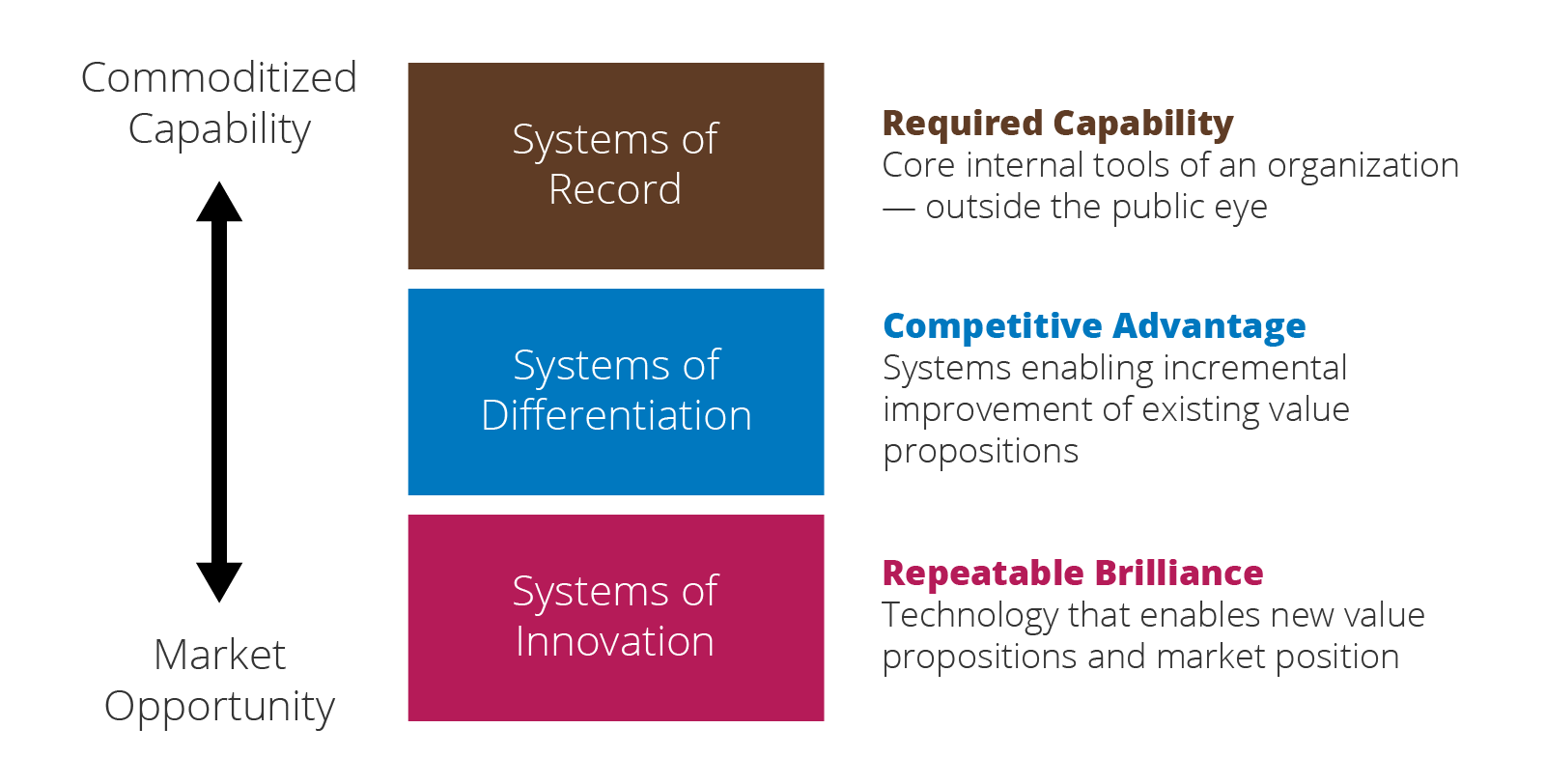
Assembling Brilliance: Systems of Innovation
There is a difficult job ahead: Global advances in technology development, falling barriers to market entry and an explosion in the number of creatively empowered individuals drives the spread of a hyper-creative economy. Market relevant innovation has become a core business capability that must be delivered over and over.
Concurrently, a Forrester Consulting study of IT and Business Leaders commissioned by Thoughtworks found that “87 percent of respondents said they would pay more for higher performance development skills.” In a competitive market where organizations need to repeatedly serve up originality to the marketplace, how should these high value custom development resources be invested?
We believe that Systems of Innovation, which leverages assembly as a key strategy, are uniquely positioned to turn the work of skilled custom software teams into organizational capabilities that deliver repeated creative brilliance on a budget.
Seeing Beyond Operational Excellence

In the past, organizations could innovate on a once-in-a-decade scale. Businesses routinely established a fundamental market position and then harvested that good idea for years. Operational performance was the key differentiator in such comparatively stable markets and “Systems of Record” were the dominant technology investment. Technology provided core internal capabilities that enabled efficiency at scale.
Today, in markets with few—if any—bounds to competition, the lifespan of a business opportunity is shorter than ever. When even the best ideas face accelerating rates of commodification and obsolescence, becoming very good at executing commodified operating tasks is a dubious strategy.
Custom Building Systems of Differentiation
Investing in market differentiation is a more promising strategy. In the Forrester Consulting study, 82% of the IT and Business leaders agreed that custom software was valued because:
- Custom build applications drove innovation
- Custom software created market differentiation
- Packaged software didn’t fit their needs
It’s not surprising that custom built “Systems of Differentiation” increasingly draw budget from Systems of Record. State-of-the-art software development teams with a mastery of user experience, solution architecture and agile development are a creative powerhouse that can both invent and deliver value propositions for the market; however, there is a problem: A growing global army of creative thinkers works incessantly to put ever more powerful ideas into the hands of customers. To survive, an organization’s offerings must be continually reinvigorated.
Short, rapidly shifting opportunities can’t be pursued with outsized creative investments. This seems like an impossible tradeoff. Highly differentiated, custom built responses are possible, but each new idea requires another individual development effort. This can be expensive and when measured against the pace of market change, progress can feel slow. How does anyone repeatedly deliver new ideas and keep the cost of innovation low?
Packages – A Fast Road to Mediocrity
Packages might seem to be the answer. They can be quickly deployed and serve a range of core business needs, but how unique and original can these efforts be? Anyone with an equivalent checkbook can match the offerings built on the back of a package.
Mass-produced mediocrity is of little use in a market that demands highly differentiated offerings. It’s not enough for new capabilities to be affordable; they must also be unique and original. We need to enable our imaginative and creative people to design high value innovations that are brilliant and cost effective.
Lego and the Art of Assembly
 Fortunately there is a different strategy well suited to this challenge: a “System of Innovation." Here technical creativity is invested in building out components that are designed for reuse and assembly.
Fortunately there is a different strategy well suited to this challenge: a “System of Innovation." Here technical creativity is invested in building out components that are designed for reuse and assembly.
It’s like designing a set of Lego blocks from which new business capabilities and offerings can be constructed. New innovations are not built from the ground up, but rather are assembled from core capabilities that can be connected in creative ways to respond to a market opportunity.
This is not just a case of toggling features on a big package deployment. A successful innovation platform accelerates the production of differentiation by enabling innovators to craft novel combinations of core business capabilities. The unimagined use case comes within reach. New offerings can be created without having to start building from a blank canvas or wrestling to revamp legacy systems.
Admittedly, common thinking often offers little encouragement for this course of action. There is a popular and insidious fallacy that technology reuse is a tax on developers. Seeing the need for cheap brilliance as an unsolvable problem, many organizations retreat from the question altogether, saying, “we can’t do that here,” and quietly sit by while being driven into obsolescence.
We strongly disagree. Assembly is a powerful idea. A single box of Legos can be used to produce radically different sculptures. Neil Gershenfeld from MIT’s Center for Bits and Atoms sees this shift from custom creation to custom assembly as a parallel to the transition from analog to digital computing that occurred over 50 years ago. Digital computers won the race with analog because well-chosen “blocks” make it possible to quickly assemble new inventions that are simultaneously unique, replicable, and testable.
Systems of Record and Systems of Differentiation have occupied much of IT's attention for the last 20 years. More ambitious goals are possible. With an Innovation Platform, organizations can progress to the institutional mastery of innovation as a core capability.
Unique Responses for Fragmenting Markets
Systems of Innovation are particularly well suited for markets that are becoming ever more personalized. Instead of relying on mass market offering that modestly satisfies the needs of many, it will be possible (and necessary) to craft offerings that are specific to individuals and the context of the moment.
Assembling offerings responds to this challenge. Service design is based on the ideology of meeting the customer’s need, at that moment of need, with the best possible one-touch solution to it. An assembled offering aimed at parents rushing children to school in the morning might plug together data gathered from home, car, and their personal wearables with data from schools and traffic. A recommendation engine that specializes in real-time context might be connected with a network serving food truck vendors to literally deliver food on the run.
That same pluggable system might tap a different set of data and different touch points to serve the needs of a visitor in town who has an hour to kill and is looking to experience local color and unique cuisine.
The marketplace is filled with untapped opportunities to assemble services that reflect unique needs. A customer browsing an online store while in a brick and mortar store (or, even more interestingly, in a competitor’s brick and mortar store) has a different set of drivers and needs than that same customer browsing online at home. Assembly also makes it possible to quickly swap parts in and out of the offering and substitute capabilities in response to the moves of competitors.
While B2C offers these obvious opportunities for customized services, the backoffice of a business can benefit from the flexibility that comes with assembly too. As services to customers become ever more varied, it becomes increasingly necessary to create supply chains that are flexible and extensible. Today’s supply chain is locked down in static, monolithic processes — assembling a supply chain to respond to real-time need in the system allows the business to pivot its capabilities to support shifting opportunities.
As markets become increasingly fragmented, it will be difficult to pay off the investment via one-off, custom-built solutions. However, if the unique offerings can be quickly assembled and re-jiggered as necessary, then originality is economically within reach.
A Maturity Model for Systems of Innovation
The effectiveness of a Systems of Innovation depends on the design of their component blocks and the creativity of its users. A Resilient Enterprise helps create the organizational environment to support this institutional imagination.

Technically, the blocks themselves are a place where sophistication can develop. Here is a simple maturity model that reflects the capacity of the building blocks available to the Innovator.
- Store-bought Blocks (Competitive): A purchased set of blocks that is available to others. Heavy emphasis is on the skill of the innovator, since others will be able to create the same types of offerings with their versions of the blocks. This is like buying Legos off the shelf.
- Proprietary Blocks (Differentiated): Custom-developed blocks that grant the innovator an opportunity to create a uniquely differentiated set of innovations. The same blocks are used over and over, but with each creation it is hard for a competitor to copy since the underlying parts are proprietary.
- Tailored Blocks (Context Specific): Original set of blocks plus the ability to add additional custom enhancements that tailor them to a unique opportunity. This combines the strategy of custom-built functionality with the strategy of assembly.
- Custom Ecosystems (Unbounded): Your original blocks are opportunistically combined with the blocks of others. The creative ecosystem shifts based on the blocks that are brought together and the range of design possibilities explodes.
In short, assembly as an innovation strategy brings advantages, even if the blocks are “off the shelf.” Additional advantages can be gained by building an original set of blocks linked to the unique insights and resources of the organization. That advantage can be amplified through tailoring blocks, and finally the game can be blown wide open by building bridges to other powerful innovation platforms outside the organization.
Thinking Differently - Architecting Splendid Blocks
Creating a System of Innovation presents a new kind of custom software development challenge. Many popular practices from lean product development (such as user centered design) and fail-fast market testing are appropriate once the blocks have been built, but not for architecting and constructing these creative ecosystems.
It also demands more than the simple slicing up of conventional systems into component services. Blocks in an Innovation Platform need to interact, performing interesting and creatively useful activities in ways that cumulatively add value. An effective System of Innovation has many creative possibilities and can be quickly reconfigured to do powerfully useful things with the components available on hand.
Designing for this is a new and worthy area of focus for custom software development teams. Their goal is more than creating modular to easily support systems. The key measure becomes the ability to deliver unplanned future capabilities, performing novel activities with limited additional development.
Designing and architecting such splendid bits of creation is every bit as challenging as building a one-off product or implementing a big package system. Getting this right is one of the great new opportunities in technology. It’s an achievement that would make possible the rapid creation of new sources of value in a market that increasingly demands repeatable brilliance.
Disclaimer: The statements and opinions expressed in this article are those of the author(s) and do not necessarily reflect the positions of Thoughtworks.















